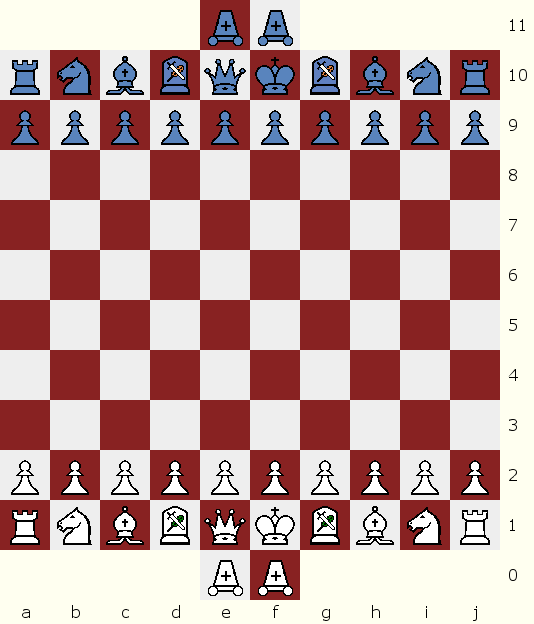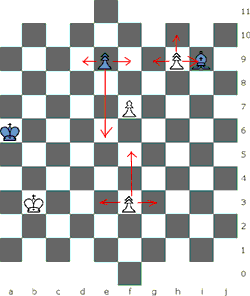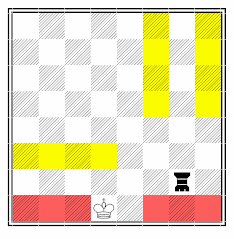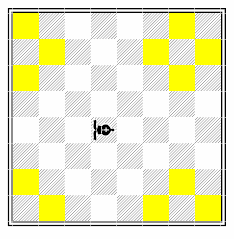Stealth Ninja Chess
Deliberate in movement, the Ninja Guards and Ninja Warriors soon become an unstoppable force, but when the Stealth Gryphon, the Anti-Gryphon and the Ninja Pawns enter the board, all hell breaks loose!Rules in a Nutshell
- The game is played on a 104 square board with 2 extra squares that protrude from the center of each side’s back rank. These squares are "in-play" throughout the game just like any other square on the board, but they are also special squares since they allow the entry of two new pieces during play.
- Each side starts with two Ninja Warriors , two Ninja Guards, two Rooks, two Bishops, two Knights, King, Queen and 10 Pawns that are setup using one of two possible starting configurations.
- The two new pieces, the Ninja Guards and the Ninja Warriors are short-range 2 space leapers and single space steppers. The Ninja Guards move along diagonals only, and the ninja warriors, orthogonal. Click here for more info on these pieces.
-
Play progresses as in chess, but each side has the option during any move to drop the following:
1 Stealth Gryphon - A powerful sliding piece that controls two files and two ranks.
1 Stealth Anti-Gryphon - Analogous to above but controlling multiple diagonals.
4 Ninja Pawns - A stronger pawn capable of capturing sideways in enemy territory.
Click here for movement of these pieces.
The stealth gryphon or anti-gryphon can enter only via one of the two rear squares. The space must be empty and the drop is considered one move.
The ninja pawns can enter via any vacant space on the 2nd rank.
The ninja pawn can be pushed forward towards the center (1-multiple spaces) on the same move. - The standard pawns advance 1-3 empty spaces from their start position and 1-2 spaces from the third rank (rank 8 for black) towards the center.
En-passant is extended for these conditions. If a pawn bypasses an enemy pawn by moving 2 or 3 spaces forward it can be captured en passant. - The castling rules have been modified. The King can transpose places with the rook by moving multiple spaces towards it. There are a total of 7 castling positions.
Board Setup
 |
Stealth Ninja Chess Main Start position
Coordinates for white. (black mirrors white) Ninja Guards on a1, j1 Rooks on b1,i1 Knights on c1,h1 Bishops on d1, g1 Queen on e1 King on f1 Ninja Warriors on e0,f0. |
 |
Stealth Ninja Chess Secondary Start position
Coordinates for white. (black mirrors white) Rooks on a1, j1 Knights on b1,i1 Bishops on c1,h1 Ninja Guards on d1, g1 Queen on e1 King on f1 Ninja Warriors on e0,f0. |
The Pieces
The Ninja Guard
Movement: The Ninja Guard is a color bound piece that can move one or two steps diagonally. It can leap over a diagonally adjacent piece to land exactly 2 squares away (a two-space diagonal leap).Capturing Mechanisms: It can capture by replacement on any square it lands.
It also can capture any diagonally adjacent enemy piece by jumping over it. It is mandatory to capture when jumping over an enemy piece.
It can capture two pieces (the first immediately adjacent to it, and the next right after) in its diagonal path by jumping over the first one and capturing the second piece on the square it lands.
The Ninja Warrior
Movement: The Ninja Warrior can move one or two steps orthoganally. It can leap over a piece to land exactly 2 squares away (a two-space orthogonal leap).Capturing Mechanisms: It can capture an enemy piece by displacement by moving into its square.
It can also capture an adjacent enemy piece by jumping over it. If jumping over an enemy piece this capture is mandatory.
It can capture two pieces (the first immediately adjacent, and the next right after) in its orthogonal path by jumping over the first one and capturing the second piece on the square it lands.
Reinforcements
The Ninja Pawn

 The ninja pawn possesses slightly different modes of movement and capture depending on which half of the board it is on.
The ninja pawn possesses slightly different modes of movement and capture depending on which half of the board it is on.
Movement:
The ninja pawn can always move 1 square up or 1 square sideways to an empty square regardless of where it is situated on the board.
From the middle exactly, (rank 5 for white, rank 6 for black), the ninja pawn can move only 1 square forward, but thereafter as soon as it enters enemy territory (the upper half of the board: White rank 6-10, and for black rank 5 - 1), the pawn can go forward either 1 OR 2 empty spaces
Capture:
Like the standard pawn it can capture one square diagonally up, regardless of which half of the board it is on.
When the ninja pawn is on the top half of board (White rank 6 +, Black rank 5-) , it can also capture one square horizontally.
There is no en passant. It cannot capture another pawn or ninja pawn en passant nor can any other pawn capture it this way.
Promotion: The ninja pawn promotes on the last row (rank 10 for white, rank 1 for black), to any piece. Promotion to a piece is mandatory so it would cease to be a pawn in the last row.
Dropping:
The ninja pawn is not present at the start at the game and is dropped by the player into the drop zone, which are the 2nd row squares (row 9 for black, 2 for white). For example, the drop zone for white is a2-j2 and for black a9-j9.
The square must be vacant to drop the pawn. You can drop a pawn to check or to checkmate the opposing king
A maximum of 4 ninja pawns (1 per turn) can be dropped by each side during a game.
After dropping a pawn, the player can optionally move the ninja pawn forward 1 or multiple squares towards the center on the same move.
A capture or a side move is not permitted during the drop, so the player can just drop a pawn, or drop a pawn and move it 1-3 vacant squares towards the center.
 |
In diagram, the black ninja pawn can go from e9-e6 or any other square in between or d9 or f9. The white pawn at f7 cannot capture it en passant Lets say the white ninja pawn went from e3-f3 , it still has the option of shooting forward to the middle (f5) regardless of how many moves it made before. e.g. it can go e2-e3, then e3-f3 . It can now (see diagram) go f3-f5 if unobstructed.The white ninja pawn at h9 can capture the bishop at i9 in addition to being able to go to g9 or to promote by going to h10. |
The Stealth Gryphon

 The Stealth Gryphon is a potentially powerful piece that can control multiple files and ranks if used effectively, and its awkward move can catch an unsuspecting opponent by surprise.
The Stealth Gryphon is a potentially powerful piece that can control multiple files and ranks if used effectively, and its awkward move can catch an unsuspecting opponent by surprise.
Movement/Capture by replacement: It must move along any unobstructed path (it cannot leap) of 1 square diagonally followed by 2 or more squares horizontally or vertically outwards. Thus, it can reach its destination square only one way but it can exert a powerful influence when not blocked.
The Achilles heel of the Gryphon (and the Anti-Gryphon) is its susceptibility to having its path blocked, and its vulnerability to close range attack.
 |
Partial board shows white king on e0 and black Stealth Gryphon on h1. Red is "offboard". Here the griffon is hampered by the edge of the board but still exerts great influence. It controls the squares in yellow but it is not checking king because it needs to go one diagonal first and then 2 or more orthogonal outwards and there is no such path towards the king. |
The Stealth Anti-Gryphon

 The Stealth Anti-Gryphon is the exact inverse of the Stealth Gryphon, and so controls multiple diagonals.
The Stealth Anti-Gryphon is the exact inverse of the Stealth Gryphon, and so controls multiple diagonals. Movement/Capture by replacement: It must move along any unobstructed path (it cannot leap) of 1 square horizontally or vertically followed by 2 or more squares diagonally outwards.
 |
Partial board shows black Stealth Anti-Gryphon on e4. Note that it will control more squares on the actual board. Anti-Gryphon shown controls the squares in yellow. Notice its long-range prowess but short-range vulnerability. Esp note how easily a piece can block its path. |
Rules
The rules in Stealth Ninja Chess are the same as in chess except for the following modifications :Reinforcements - Dropping pieces
Players have the option to drop pieces during the game.- A piece may be dropped on any empty rear square (e0,f0 for white, e11,f11 for black) at any time.
- Dropping a piece constitutes a move.
- A piece can deliver check or checkmate when dropped.
- A piece can block a check when dropped.
One Stealth Gyrphon and one Stealth Anti-Gyrphon in the manner described above.-
Reinforcements - Dropping 4 Ninja Pawns.
There is a special drop zone and associated drop rule for Ninja Pawns.
The ninja pawns can be dropped into any empty square on the 2nd rank. And, the Ninja Pawn can be optionally pushed forward (1- multiple empty spaces) on the same move. -
Castling:
Unlike standard Chess, castling is flexible with the king able to travel 1, 2, 3, or 4 squares towards the rook.
There are 7 possible castling positions, the most extreme wing castling involves the king relocating to the b or i file. The choice of castling positions will depend on whether it is immediately necessary for the king to be tucked away at the wing or for the rook to be centralized.
The usual castling criteria apply: No piece can occupy the spaces travelled by the king and castling rook. Cannot castle out of check. King cannot pass over or land on squares attacked by enemy, but rook can.-
1 space transposition - King Side Castling
White moves King one space from f1-g1 and rook from i1-f1
Black moves King one space from f10-g10 and rook from i10-f10 -
1 space transposition - Queen Side Castling
White moves King one space from f1-e1 and rook from b1-f1
Black moves King one space from f10-e10 and rook from b10-f10 -
2 space transposition - King Side Castling
White moves King two spaces from f1-h1 and rook from i1-g1
Black moves King two spaces from f10-h10 and rook from i10-g10 -
2 space transposition - Queen Side Castling
White moves King two spaces from f1-d1 and rook from b1-e1
Black moves King two spaces from f10-d10 and rook from b10-e10 -
3 space transposition - King Side Castling
White moves King three spaces from f1-i1 and rook from i1-h1
Black moves King three spaces from f10-i10 and rook from i10-h10 -
3 space transposition - Queen Side Castling
White moves King three spaces from f1-c1 and rook from b1-d1
Black moves King three spaces from f10-c10 and rook from b10-d10 -
4 space transposition - Queen Side Castling
White moves King four spaces from f1-b1 and rook from b1-c1
Black moves King four spaces from f10-b10 and rook from b10-c10
Any other piece can occupy j1, j10, a10 or a1 during castling. -
1 space transposition - King Side Castling
-
Pawn Movement ():
The pawn can move from its original position either 1, 2 or 3 vacant squares forward.
A pawn, which initially moved forward 1 square or captured from its starting position, can subsequently at any time move forward 1 or 2 vacant squares. Once it reaches the center of the board (rank 5 for white, rank 6 for black), it can move forward only one square at a time.
Some examples: the white pawn at f2 can start f2-f5 or it can move f2-f4 then f4-f5, or f2-f3 followed by f3-f5, or move f2-g3 to capture enemy piece at g3 followed by g3-g5 next time it moves. - En Passant: If a Pawn moves two or three squares initially and passes an enemy Pawn on the
4th or 5th rank, it may be captured en passant by the enemy pawn.
E.g. White pawn on a2 black pawn on b4. White pawn moves a2 - a4 (or a5), black pawn on b4 can capture it as if it had moved to a3.
Similarly, black pawn on b5 and white pawn moves a2 - a5, then black pawn can capture the white pawn as if it moved to a4. Note in this case the white pawn can still avoid the black pawn by moving to a3 instead.
If a pawn slides forward 2 squares on its second move, it can also be captured en passant by an opposing pawn on the fifth rank. E.g. white pawn on a3 and black pawn on b5. White plays a3-a5, black pawn on b5 can capture the pawn en passant by moving to a4.
Capturing en passant is optional unless it is the only legal move available. The capture must be made on the next move. - Ninja Pawns are exempt from En Passant.
- Pawn promotion: Pawns can now promote to any piece (except the ninja pawn) on the 10th rank only.
Interesting Notes
It is advisable for players to start of with the recommended rule-set: Board 1 with ability to drop 4 ninja pawns, Gryphon and Anti-Gryphon, and no other optional rules. This setup is the very essence of the game.Then the other rules: piece promotion, capture the scepter can be tried.
- The ninja pawns as pieces. While they share many characteristics with normal pawns, they have additional powers that make them far more powerful. Thus, they can be regarded as pieces. They must promote to a piece and no pawn can promote to ninja pawn.
- Relative Values: It is sometimes hard to gauge the relative values of the pieces. Here is a rough guideline:
Knight=3 pawns
Bishop=4 pawns
With no piece promotion:
Ninja Guard ~ 3.3 pawns
Ninja Warrior ~ 3.2-4.5 pawns (later on it improves since it can help mate a king)
Ninja Pawn ~ 1.5 pawns
Rook=6 pawns
Stealth Gryphon ~ 3.5 - 4.5 pawns
Anti-Gryphon ~ 3-4.5 pawns
Queen=11 pawns. -
Ability to Checkmate:
The Ninja Guard alone cannot mate a lone king with the aid of a king, but two opposite colored ninja guards can.
The Ninja Warrior with the aid of the king can checkmate a lone king, though it is a bit tricky since the king can escape at times.
The Anti-Gryphon cannot. Stealth Gryphon also cannot! The lone King basically just needs to move towards the Stealth Gyrphon and in most cases the mate cannot be forced. (Note that the original Gryphon can checkmate).
The super-Cannon cannot but the Flying Bomber can. - Knight vs Bishop: Because of the larger board, exchanging a bishop for a knight is definitely losing the exchange, though there are some exceptions.
Play the Game!
Play a game of Stealth Ninja Chess!
Play Stealth Ninja Chess using secondary Board (Free Registration at chessvariants.org required).Click here to View Game Logs of Stealth Ninja Chess
 Download Zillions of Games File
Download Zillions of Games File
Example Games
Optional Rules
Below are some optional rules that can be tried:Ninja Piece Promotion - The Insane Ninja
The Ninja Guards or Ninja Warriors can promote to more powerful versions - Insane Ninjas, if they can safely land in the opposite side's rear squares. Thus, for promotion, white's ninja pieces must occupy e11 or f11 or black's must occupy e0, f0.The Insane Ninja combines the movement/capture modes of the Ninja Guard and Ninja Warrior.
Capture the Scepter
Each side stores a scepter in the rear center squares (e0, f0, e11,f11). If the opposing king can occupy any of these squares (e11,f11 for white or e0,f0 for black), the game is drawn.This rule is best used in conjunction with the Ninja Piece Promotion rule. It allows an extra resource for the weaker side. An example of possible use: one side is down to a bare king while the other is up a ninja guard. The stronger side can easily promote the Ninja Guard to Insane Ninja and win, but if the weaker side's king can reach the opposite side's rear squares safely, the game is drawn.
This rule is almost identical to the rule with same name for Birds and Ninjas. The difference is in the outcome of the game. Here the game is drawn while in Birds and Ninjas it is a win for the side that captures the scepter.
|
If you would like to email the chess variant inventor directly: inventor@chess.computerwebservices.net
|
|
Posted by: Mo on 2008-09-04 07:47:47
Don't get it. |

